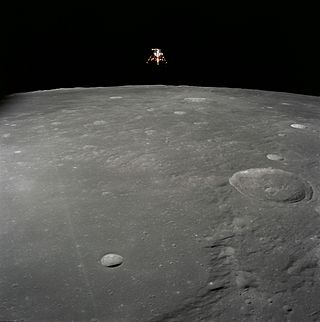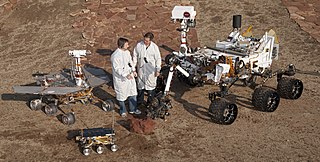Other uses
- Pragyan (festival), the technical festival of the National Institute of Technology, Tiruchirappalli
- Pragyan (rover), an Indian lunar rover that landed in 2023
- Pragyan International University, a private university in Ranchi, India
Pragyan may refer to:

A lander is a spacecraft that descends towards, then comes to rest on the surface of an astronomical body other than Earth. In contrast to an impact probe, which makes a hard landing that damages or destroys the probe upon reaching the surface, a lander makes a soft landing after which the probe remains functional.

The Indian Space Research Organisation, commonly referred to as ISRO, is the national space agency of India. It operates as the primary research and development arm of the Department of Space (DoS), which is directly overseen by the Prime Minister of India, while the Chairman of ISRO also acts as the executive of DoS.

Chandrayaan-1 was the first Indian lunar probe under the Chandrayaan programme. It was launched by the Indian Space Research Organisation (ISRO) in October 2008, and operated until August 2009. The mission included an orbiter and a MIP. India launched the spacecraft using a PSLV-XL rocket on 22 October 2008 at 00:52 UTC from Satish Dhawan Space Centre, at Sriharikota, Andhra Pradesh. The mission was a major boost to India's space program, as India researched and developed indigenous technology to explore the Moon. The vehicle was inserted into lunar orbit on 8 November 2008.

A Moon landing or lunar landing is the arrival of a spacecraft on the surface of the Moon. This includes both crewed and robotic missions. The first human-made object to touch the Moon was the Soviet Union's Luna 2, on 13 September 1959.

Pragyan, NIT Trichy is the technical festival of the National Institute of Technology, Tiruchirappalli. Since its inception in 2005, it has been held every year over a period of three and a half days during the months of January, February, or March. Every year, participants from a number of colleges across the country take part in various events conducted as a part of Pragyan, making it one of the largest techno-managerial fests in India. It is also the first student-run organisation in the world and the third overall, next only to the London Olympics and Manchester United to get an ISO 20121:2012 certification for Sustainable Event Management. It also holds the ISO 9001:2015 certification for Quality Management Systems.

The physical exploration of the Moon began when Luna 2, a space probe launched by the Soviet Union, made an impact on the surface of the Moon on September 14, 1959. Prior to that the only available means of exploration had been observation from Earth. The invention of the optical telescope brought about the first leap in the quality of lunar observations. Galileo Galilei is generally credited as the first person to use a telescope for astronomical purposes; having made his own telescope in 1609, the mountains and craters on the lunar surface were among his first observations using it.

Mylswamy Annadurai, popularly known as Moon Man of India, is an Indian scientist working as vice president for Tamil Nadu State Council for Science and Technology (TNSCST), Chairman, Board of Governors, National Design and Research Forum(NDRF. He was born on 2 July 1958, in a village called Kothavadi near Pollachi in Coimbatore district, Tamil Nadu state of India). Prior to taking this assignment he was with Indian Space Research Organisation and served as Director, ISRO Satellite Centre (ISAC), Bangalore. During his 36 years of service in ISRO, he had some of the major contributions, including two of the major missions of ISRO, namely Chandrayaan-1 and Mangalyaan. Annadurai has been listed among 100 Global thinkers of 2014 and topped the innovators list. His works are mentioned in textbooks of Tamil Nadu Board of Secondary Education

A rover is a planetary surface exploration device designed to move across the solid surface on a planet or other planetary mass celestial bodies. Some rovers have been designed as land vehicles to transport members of a human spaceflight crew; others have been partially or fully autonomous robots. Rovers are typically created to land on another planet via a lander-style spacecraft, tasked to collect information about the terrain, and to take crust samples such as dust, soil, rocks, and even liquids. They are essential tools in space exploration.

Chandrayaan-2 is the second lunar exploration mission developed by the Indian Space Research Organisation (ISRO), after Chandrayaan-1. It consists of a lunar orbiter, and formerly included the Vikram lander and the Pragyan rover, all of which were developed in India. The main scientific objective is to map and study the variations in lunar surface composition, as well as the location and abundance of lunar water.

A lunar rover or Moon rover is a space exploration vehicle designed to move across the surface of the Moon. The Apollo Program's Lunar Roving Vehicle was driven on the Moon by members of three American crews, Apollo 15, 16, and 17. Other rovers have been partially or fully autonomous robots, such as the Soviet Union's Lunokhods, Chinese Yutus and the Indians Pragyan. Four countries have had operating rovers on the Moon: the Soviet Union, the United States, China and India. Japan and Greece currently have planned missions.

The Chandrayaan programme also known as the Indian Lunar Exploration Program is an ongoing series of outer space missions by the Indian Space Research Organization (ISRO) for the exploration of the Moon. The program incorporates a lunar orbiter, an impactor, a soft lander and a rover spacecraft.

Sivan Kailasavadivu is an Indian space scientist who served as the Secretary of the Department of Space and chairman of Indian Space Research Organisation and Space Commission. He has previously served as the Director of the Vikram Sarabhai Space Center and the Liquid Propulsion Systems Centre.

Sreedhara Panicker Somanath, better known as S. Somanath, is an Indian aerospace engineer serving as the chairman of the Indian Space Research Organisation (ISRO). Under his chairmanship, ISRO carried out the third Indian lunar exploration mission named Chandrayaan-3. The lander named Vikram and the rover named Pragyan landed near the lunar south pole region on 23 August 2023 at 18:04 IST, making India the first country to successfully land a spacecraft near the lunar south pole and the fourth country to demonstrate soft landing on the Moon.

Pragyan is an Indian lunar rover that forms part of Chandrayaan-3, a lunar mission developed by the Indian Space Research Organisation (ISRO). A previous iteration of the rover was launched as part of Chandrayaan-2 on 22 July 2019 and was destroyed with its lander, Vikram, when it crashed on the Moon on 6 September. Chandrayaan-3 launched on 14 July 2023, with Pragyan successfully landing near the lunar south pole on 23 August.
The Lunar Polar Exploration Mission (LUPEX) or Chandrayaan-4 is a planned joint lunar mission by the Indian Space Research Organisation (ISRO) and Japan Aerospace Exploration Agency (JAXA). The mission would send an uncrewed lunar lander and rover to explore the south pole region of the Moon no earlier than 2026. JAXA is likely to provide the under-development H3 launch vehicle and the rover, while ISRO would be responsible for the lander.

Chandrayaan-3 is the third Indian lunar exploration mission under the Indian Space Research Organisation's (ISRO) Chandrayaan programme. It consists of a lander named Vikram and a rover named Pragyan, similar to those of the Chandrayaan-2 mission. The propulsion module carried the lander and rover configuration to lunar orbit in preparation for a powered descent by the lander.
Pragyan Medhi is an Indian professional footballer who plays as a midfielder for Indian Super League club NorthEast United.
Amitabh Singh is an Indian Space Scientist. He was Project Manager for Chandrayaan-1 Mission and Deputy Project Director & Operation Director for Chandrayaan-2 Mission at Indian Space Research Organization. He handled the optical payload data processing and on-board algorithm related to Chandrayaan-2 Lander and Rover. He is also a Guest Faculty at Department of Physics, Electronics & Space Science of the Gujarat University. He is working for upcoming Chandrayaan-3 project.